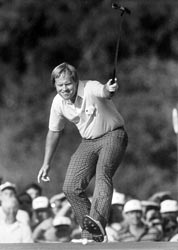The author of this site is a classic example of turning lemons into lemonade.
The son of a Baptist minister and growing up in upstate New York in the 1950s, Gary Edwards wasn't a candidate for the football team, nor salutatorian of his high school class in Corning.
He did have a hunger for competition and the want to play major league baseball but his slight physical build, lack of speed and strength meant that was never a possibility. When a brief trip through electronics school in the Air Force ended in failure, he was given the option to become a photographer and the rest, at least at the personal level, is history.
His journey from the 4 X 5 Speed Graphic he was taught to use at the Shaw Air Force  Base Photo Lab in 1959 to his being nominated for a Pulitzer Prize in 1986 for a photograph taken of Jack Nicklaus winning the Masters Golf Tournament was just another step in a career marked with, "good luck creating opportunity."
Base Photo Lab in 1959 to his being nominated for a Pulitzer Prize in 1986 for a photograph taken of Jack Nicklaus winning the Masters Golf Tournament was just another step in a career marked with, "good luck creating opportunity."
The fact he took advantage of the many opportunities along the way allows Edwards to tell young people just beginning their journey how they can prepare themselves for their own opportunities.
"There are," he loves to tell them, "only a few opportunities in life so be ready to take advantage of them when they arrive."
By the time he left the Air Force in 1962 he was already in love with photography and within a year he was on the staff of his hometown newspaper, being taught to write by his mentor of that time, Richard Peer.
"To succeed at anything, it helps if one has a mentor and Dick was mine at that time in my life," Edwards says. There would be others along the way. Very few among us become successful without help from someone else, he says, "So remember to treat others with respect at every step of your journey."
 His three year stint at the local newspaper provided an opportunity to photograph Cornell University football for United Press International and it was at one of their games in the fall of 1965 that a field goal kicker by the name of Charlie Gogolak made a 54-yard field goal, setting a college record. The important part and the luck of the moment was Cornell's standing their defensive backs on the shoulders of the defensive tackles, also standing up, in an attempt to block the kick. As the ball cleared the fingertips of the two-tiered defenders, Edwards shot one frame from more than 60 yards away and when it ran on the UPI wire, Life Magazine contacted Edwards and they printed it full page, grain and all, (Page 48, Oct. 22, 1965) and it didn't matter to Edwards that they cropped the football out of the picture.
His three year stint at the local newspaper provided an opportunity to photograph Cornell University football for United Press International and it was at one of their games in the fall of 1965 that a field goal kicker by the name of Charlie Gogolak made a 54-yard field goal, setting a college record. The important part and the luck of the moment was Cornell's standing their defensive backs on the shoulders of the defensive tackles, also standing up, in an attempt to block the kick. As the ball cleared the fingertips of the two-tiered defenders, Edwards shot one frame from more than 60 yards away and when it ran on the UPI wire, Life Magazine contacted Edwards and they printed it full page, grain and all, (Page 48, Oct. 22, 1965) and it didn't matter to Edwards that they cropped the football out of the picture.


